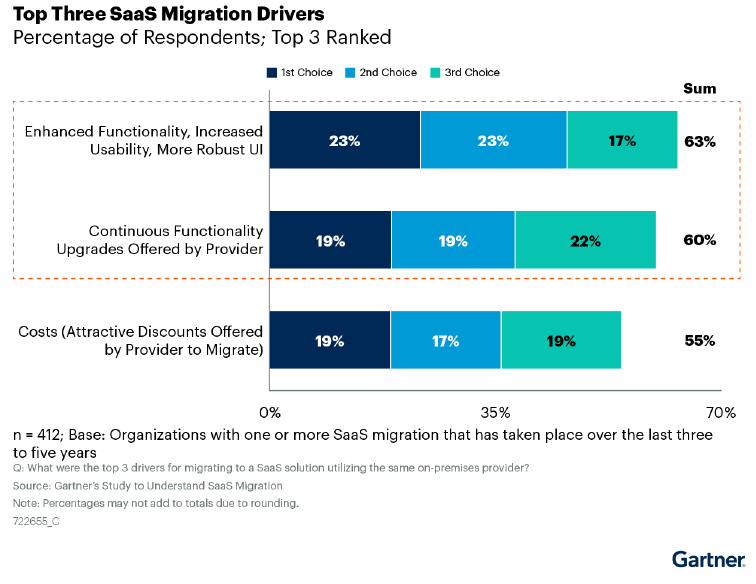Cloud migration remains high on this year's agenda for CIOs. The transformation of IT is well underway, but in addition to the intended benefits, there are many hurdles to overcome. The path to the cloud requires time and a willingness to change, as well as the courage to invest in new processes and tools. For successful modernization, all those involved must pull together: IT, business departments, and management. After all, cloud migration is not just a technical innovation, but changes the entire organization. A recent study by Gartner (Build the Right Justification for Moving to the Cloud) asked over 400 IT Infrastructure & Operations (I&O) executives worldwide about their experiences and provides tips on how you, as the person in charge, can best communicate cost savings and the business-enhancing benefits of cloud adoption.
Key challenges for cloud migration
Every move to the cloud is unique. Accordingly, there is no off-the-shelf solution, and each company must consider a variety of technical and non-technical aspects. The target scenario is usually an efficient multi-cloud architecture that can optimally distribute workloads across public, private, or edge cloud resources. However, getting there is extremely challenging. In practice, compliance, cost optimization, and performance constraints prevent you as an I&O manager from migrating all workloads to the public cloud. This forces you to evaluate each workload and highlight the benefits. However, each workload is a different cost model because data center applications are an investment cost, while the operating cost model applies to cloud systems. This makes it difficult for managers to precisely quantify the costs of individual workloads.
The topic of data security is also in focus: During cloud migration, the security architecture must be comprehensively adapted to prevent data loss and theft, as well as data protection breaches. This requires not only appropriate tools for updating and ensuring security and compliance policies, such as software asset management systems, but also competent employees who have the relevant know-how to manage complex environments securely.
Another key challenge is full transparency of cloud application performance and system utilization and availability - this requires professional monitoring of your hybrid cloud infrastructure.
What are the drivers for a cloud migration?
Cloud computing is the foundation for tomorrow's digital business. It frees IT organizations from running business systems and allows IT staff to focus their time and energy on systems that support innovation and growth. More and more critical, but not business-critical, systems and resources are being migrated to SaaS applications, for example, human capital management, email and collaboration tools, procurement and sourcing, CRM, and IT service management.
According to Gartner, the main reasons cited by business leaders for migrating to corresponding SaaS offerings are improved functionality, a better user interface and, in general, greater ease of use. The possibility of convenient, smooth function upgrades and the attractive entry costs are other motives cited for a switch to the cloud.

Download your free copy of the Gartner report "Build the Right Justification for Moving to the Cloud" and get answers to your questions.
How to best market the move to the cloud
Winning the internal support required for a cloud migration project depends on your argumentation. Based on the above survey, Gartner has listed a number of possible arguments in this regard that could positively influence a decision:
- Agility and scalability: the ability to adapt flexibly to changing business requirements at all times is a prerequisite for growth
- Innovation: Cloud enables low barriers to entry for otherwise time-consuming and costly development of innovative products and prototyping
- Geographic distribution: global distribution of cloud infrastructure and platform services (IaaS, PaaS) is possible quickly and cost-effectively
- Cost optimization: cloud costs are incurred according to the on-demand principle. This minimizes classic upfront investment costs. To achieve corresponding savings potential, it is important to transparently compare the different cost models.
- Higher availability: application security and availability of the large IaaS or PaaS providers have now reached a very high level.
- Shorter project times: based on cloud IaaS, a dynamic trial and error model can quickly evaluate a business model’s success.
- Technical flexibility: IT teams are relieved of the responsibility for configuring and operating servers, storage, network, and data centers.
Key recommendations for a successful cloud project
IT managers responsible for infrastructure and operations should consider the following core recommendations in preparation for their cloud migration project:
- Determine which workloads should be migrated to the cloud by identifying and prioritizing IT competencies and applications that are critical to differentiating your business, while providing the maximum benefit for the minimum effort and cost.
- Create meaningful cost overviews and comparisons for each scenario. Consider potential savings and your organization's business objectives.
- Combine your cost-intensive private cloud project with other quick-win initiatives (e.g., a data center migration or hardware refresh program) so your overall solution reduces infrastructure complexity and increases agility, while meeting security and compliance requirements.
